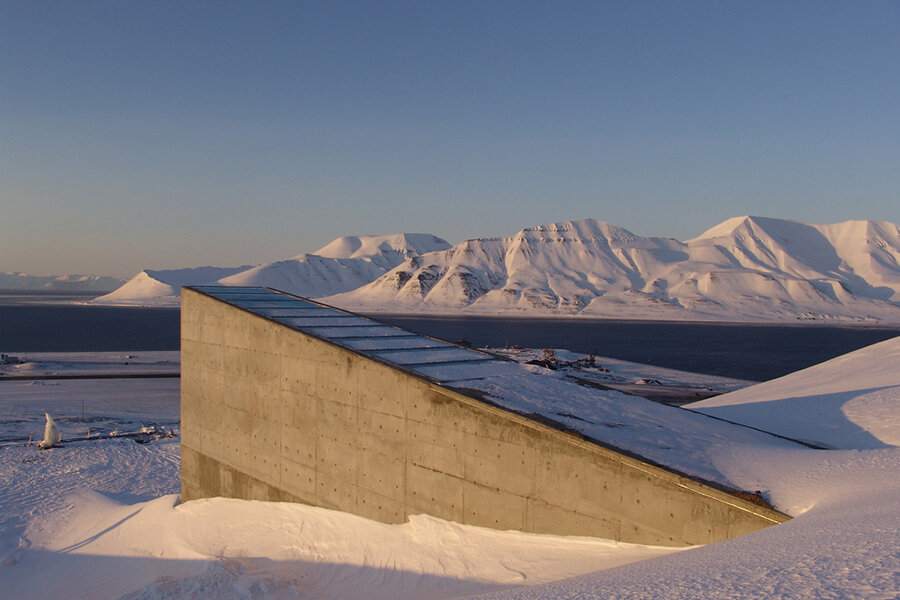War in Syria prompts first opening of global doomsday seed vault
The inaugural withdrawal from the Svalbard "doomsday" Global Seed Vault in Norway is being made, not due to natural disaster, but because war in Syria is threatening to derail scientific research into drought-tolerant plants and crops.
The Seed Vault is true to its name in that nations deposit seeds grown in their country and then only that nation may to withdraw them upon request. Accounts grow through continued deposits. The goal is to preserve biodiversity in times of global disaster.
There are currently more than 1,700 gene banks in the world, according to The Crop Trust’s website, “yet many of these are vulnerable, exposed not only to natural catastrophes and war, but also to avoidable disasters, such as lack of funding or poor management.”
Svalbard, the world's largest gene bank, was built in 2008 and houses around 864,000 samples. The stock is being added to constantly and the total capacity is estimated to be around a maximum of 2.5 billion seeds. The Arctic permafrost is expected to keep stocks frozen at around minus 18 degrees Celsius for approximately 200 years.
When war broke out in Syria, another gene bank, The International Center for Agricultural Research in the Dry Areas (ICARDA) in the Middle East, was forced to move its headquarters, shifting from the embattled city of Aleppo, Syria, to Beirut, Lebanon, in 2012. Because the move was made under difficult circumstances, many seeds were left behind. Many of ICARDA’s facilities are currently located in areas known for frequent unrest and civil war, including Islamabad, Pakistan; Sudan; Kabul, Afghanistan; Uzbekistan, and Yemen.
That's where the Svalbard vault comes in. ICARDA has requested 130 of the 325 boxes of their seed currently being stored in Scandinavia – 116,000 samples – which they had deposited with the organization.
“This is the type of disaster that is absolutely expected, and the real reason for the Svalbard Global Seed Vault,” says Colin Khoury, a research scientist and crop diversity specialist for the International Center for Tropical Agriculture (CIAT) in an interview. Mr. Khoury works at the US National Center for Genetic Resource Preservation (NCGRP) in Ft. Collins, Colorado. “The real/imminent threats to crop diversity held in seed banks are the daily disasters – electricity going off for a few days; not enough money to support staff, etc. These are happening all the time in different parts of the world and make the seed vault at Svalbard such a good idea.”
Khoury adds that natural disasters happen too, an example being “the loss of most of the collections at the Philippine National seed bank due to a typhoon a few years ago; and war and civil strife, loss of the national seed banks of Iraq and Afghanistan; ICARDA.”
“SGSV wasn’t built to save us from doomsday, or perhaps better put, doomsdays happen every day for seeds. Thus, Svalbard is there to help us in the different parts of the world that have their daily doomsdays,” Khoury concludes.
According to Brian Lainoff, partnership and communications officer at the Crop Trust, which provides ongoing support for the operations of the Global Seed Vault, “Protecting the world’s diversity of seed crops – which forms the basis of global agriculture – is vitally important for ensuring food security, sustainable agriculture and defending against the effects of climate change on crops.”
Camellia Moses Okpodu, Norfolk (Va.) State University’s Research Director, STEM educator and botanist who is currently teaching a course on food insecurity says in an interview, “It’s very hard to contextualize this for people here in the United States who have never known this kind of disaster situation, except perhaps with Hurricane Katrina and we got food in there because nobody was firing at us.”
“Outside of the issue with scientific researchers not having access to the supply ICARDA had in Syria, in times of war the seed distribution and supply are interrupted for the nation itself,” Okpodu explains. “It’s something we don’t think about because we are – and rightly so – concerned with the human tragedy going on. But this too is a cost of war.”
A Crop Trust spokesperson adds that, “While we are unable to comment on the farming situation in Syria, the fact that ICARDA made their deposit with the Crop Trust and are now able to withdraw seeds from Svalbard means their vital research and the collaborative work they are doing with other researchers on plant breeding and preserving biodiversity in the region can continue.”








